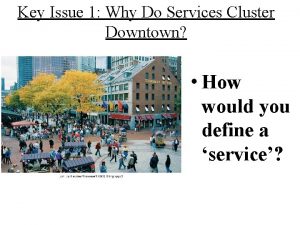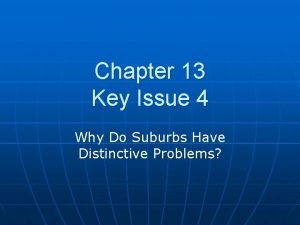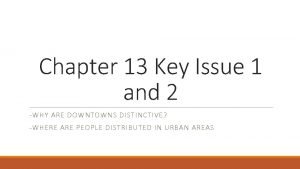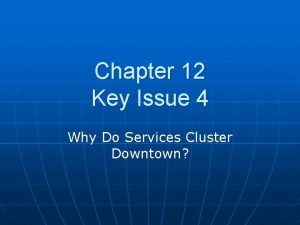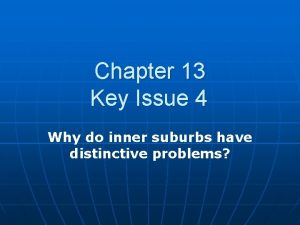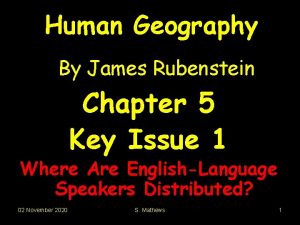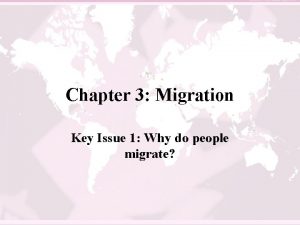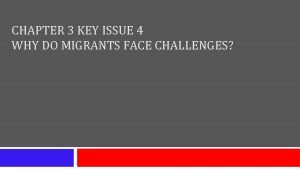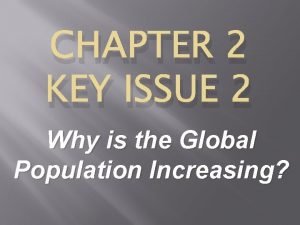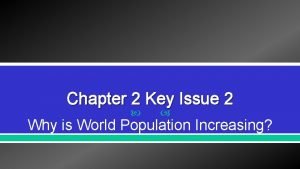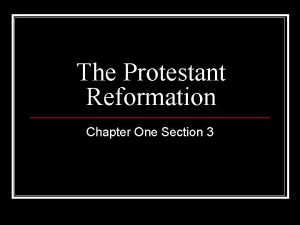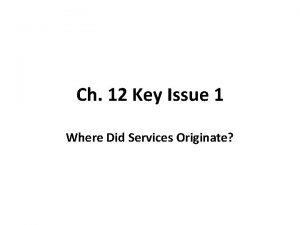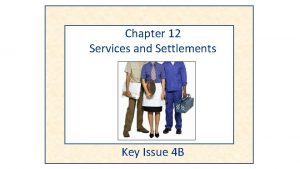Chapter 12 Services Key Issue 1 WHERE DID


























- Slides: 26

Chapter 12 Services

Key Issue #1 WHERE DID SERVICES ORIGINATE?

Services Service = any activity that fulfills a human want or need Services are located in settlements Location of services is important for profitability Affluent regions tend to offer more services Local diversity is evident in the provision of services

Where Did Services Originate? Three types of services Consumer services About 44 percent of all jobs in the United States Business services About 24 percent of all jobs in the United States Public services About 17 percent of all jobs in the United States In the United States, all employment growth has occurred in the services sector

Percentage of GDP from Services, 2005 Figure 12 -1

Employment Change in the United States by Sector Figure 12 -2

Where Did Services Originate? Services in early rural settlements Early consumer services met societal needs Examples = burial of the dead, religious centers, manufacturing centers Early public services probably followed religious activities Early business services to distribute and store food

Where Did Services Originate? Services in early urban settlements Services in ancient cities Earliest urban settlements (e. g. , Ur), Athens, Rome Services in medieval cities Largest settlements were in Asia European cities developed with feudalism

Where Are Contemporary Services Located? Services in rural settlements Half of the world’s population lives in rural settlements Two types Clustered rural settlements Circular or linear Clustered settlements in Colonial America Dispersed rural settlements In the United States In Great Britain Enclosure movement

Rural Settlement Patterns Figure 12 -10

Where Are Contemporary Services Located? Services in urban settlements Differences between urban and rural settlements Large size High density Social heterogeneity Increasing percentage of people in cities Increasing number of people in cities

Percentage of Population Living in Urban Settlements Figure 12 -14

Urban Settlements With Populations of at Least 3 Million Figure 12 -15

Key Issue #2 WHY ARE CONSUMER SERVICES DISTRIBUTED IN A REGULAR PATTERN?

Why Are Consumer Services Distributed in a Regular Pattern? Central place theory First proposed by Walter Christaller (1930 s) Characteristics A central place has a market area (or hinterland) Size of a market area Range-max distance people are willing to travel to use a service. Threshold-min # of people needed to support a service.

Central Place Theory Fig. 12 -5: Hexagons are often used to delineate market areas because they are a compromise between circles, which have edges equidistant from the center but leave gaps, and squares, which don’t leave gaps but whose edges are not equidistant from the center.

Market Areas, Range, and Threshold for Kroger Supermarkets Figure 12 -18

Why Are Consumer Services Distributed in a Regular Pattern? Market-area analysis The Gravity Model Predicts that the optimal location of a service is directly related to the # of people in the area and inversely related to the distance people must travel to access it. Consumer behavior reflects 2 patterns: The greater the # of people living in a place, the greater the # of potential customers for a service. The farther people are from a particular service, the less likely they are to use it.

Optimal Location for a Pizza-Delivery Service Figure 12 -20

Central Place Theory Figure 12 -21

Why Are Consumer Services Distributed in a Regular Pattern? Hierarchy of services and settlements Rank-size distribution of settlements Rank-size rule The country’s nth largest settlement is 1/n the population of the largest settlement. For ex, the 2 nd largest city is one-half the size of the largest Primate city rule The largest settlement has more than twice as many people as the second-ranking settlement The country’s largest city is called a primate city For ex, Paris is a primate city b/c it has 11 m people, while the 2 nd largest city, Lyon, has 2 m people

Rank-Size Distribution in the United States and Indonesia Figure 12 -23

Key Issue #4 WHY DO SERVICES CLUSTER DOWNTOWN?

Central Business District Historically, services of all types clustered in the center of the city, commonly called downtown and known to geographers by the more precise term central business district (CBD). Recently services, especially retail, have moved from the CBD to the suburbs. © 2011 Pearson Education, Inc.

Central Business District 3 types of retail activities concentrate in the CBD: High threshold shops, like department stores, preferred CBDs to give access to many people. High range shops are very specialized, with customers who patronize infrequently; ex. include expensive jewelry or furs Shops that serve people who work in the CBD © 2011 Pearson Education, Inc.

Central Business District The CBD produces extreme competition for the limited sites available. Land value in CBDs is very high Cities have grown vertically—skyscrapers 1 st were in Chicago (elevators and iron-frame bldgs) None in Washington, D. C. © 2011 Pearson Education, Inc.
 Why do services cluster downtown
Why do services cluster downtown Key issue 1: where are services distributed?
Key issue 1: where are services distributed? Chapter 12 key issue 2
Chapter 12 key issue 2 Where did agriculture originate
Where did agriculture originate Chapter 13 key issue 3
Chapter 13 key issue 3 Chapter 13 key issue 1
Chapter 13 key issue 1 Chapter 12 key issue 1
Chapter 12 key issue 1 Chapter 11 key issue 4
Chapter 11 key issue 4 Key issue 4 why do countries face obstacles to development
Key issue 4 why do countries face obstacles to development Chapter 5 key issue 1
Chapter 5 key issue 1 Chapter 5 key issue 4
Chapter 5 key issue 4 Chapter 4 key issue 3
Chapter 4 key issue 3 Chapter 13 key issue 4
Chapter 13 key issue 4 Chapter 5 key issue 1 ap human geography
Chapter 5 key issue 1 ap human geography Chapter 6 key issue 4
Chapter 6 key issue 4 Chapter 5 key issue 2
Chapter 5 key issue 2 Chapter 4 key issue 2
Chapter 4 key issue 2 Chapter 3 key issue 1
Chapter 3 key issue 1 Chapter 3 key issue 4
Chapter 3 key issue 4 Key issue 3 why do some places face health challenges
Key issue 3 why do some places face health challenges Chapter 2 key issue 2
Chapter 2 key issue 2 Chapter 2 key issue 1
Chapter 2 key issue 1 Bulk gaining or bulk reducing
Bulk gaining or bulk reducing Public issue management functions
Public issue management functions The renaissance and reformation section 3 quiz answer key
The renaissance and reformation section 3 quiz answer key Key patners
Key patners Contoh bisnis model canvas makanan pdf
Contoh bisnis model canvas makanan pdf
